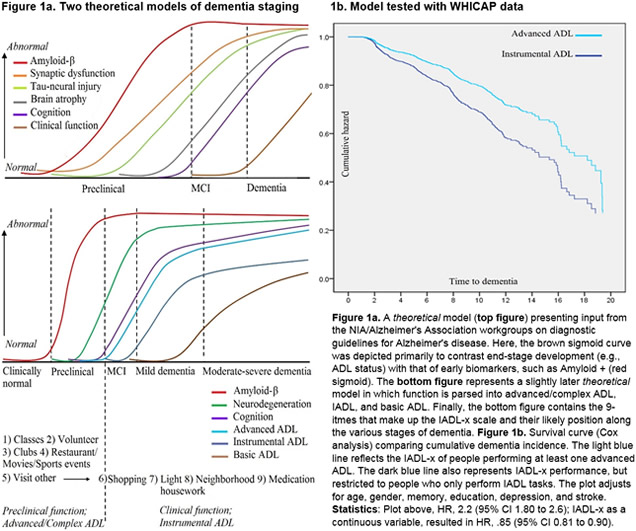Columbia University
Irving Medical Center
Neurological Institute
710 West 168th Street, 3rd floor
(212) 305-1818
TaubCONNECT Research Perspectives:
December 2017
Disease-Like Pathology
and
» The Endosomal–Lysosomal Pathway Is Dysregulated by APOE4 Expression in Vivo
2: » The Historical Progression from ADL Scrutiny to IADL to Advanced ADL: Assessing Functional
Status in the Earliest Stages of Dementia
» First Place: Microglia Identity in the Aged and AD Human Brain
» #1 Intra-Axonal Synthesis of SNAP25 is Required for the Formation of Presynaptic Terminals
» #1 Atabilization of Dynamic Microtubules by mDia1 Drives Tau-dependent Aβ1-42 Synaptotoxicity
» #2 LTP and Memory Impairment Caused by Extracellular Aβ and Tau Oligomers is APP-Dependent
» #2 Neuropathologic Features of TOMM40 '523 Variant on Late-Life Cognitive Decline
» #2 An Approach to Studying the Neural Correlates of Reserve
» #1 Brain Atrophy Can Introduce Age-Related Differences in BOLD Response
» #2 Age-Related Biomarkers in LLFS Families With Exceptional Cognitive Abilities
» #2 Polygenic Risk Scores in Familial Alzheimer Diseases
» #1 Local Synthesis of Dynein Cofactors Matches Retrograde Transport to Acutely Changing Demands
» #3 Relation of Dysglycemia to Structural Brain Changes in a Multiethnic Elderly Cohort
» First Place: White Matter Changes in Alzheimer's Disease
» Alzheimer's Association International Conference (AAIC 2016)
» #1 Neuronal activity enhances tau propagation and tau pathology
» #2 Sleep Disordered Breathing and White Matter Hyperintensities in Community-Dwelling Elders
» #2 Dementia Risk and Protective Factors Differ in the Context of Memory Trajectory Groups
» #2 Parkinson's Disease: Guilt by Genetic Association
» #1 PDE5 Exists in Human Neurons and is a Viable Therapeutic Target for Neurologic Disease
» #1 Extracellular Tau Oligomers Produce An Immediate Impairment of LTP and Memory
» #3 Mediterranean Diet and Brain Structure in a Multiethnic Elderly Cohort
» #2 Novel Selective Calpain 1 Inhibitors as Potential Therapeutics in Alzheimer's Disease
» #1 First Place: DREADDs Activation in the Medial Entorhinal Cortex (MEC) of EC-Tau Mice
» #1 F-box/LRR-repeat protein 7 is genetically associated with Alzheimer's disease
» #2 The keystone of Alzheimer pathogenesis might be sought in Aβ physiology
» #1 Stereotaxic Infusion of Oligomeric Amyloid-beta into the Mouse Hippocampus
» #1 SUMO1 Affects Synaptic Function, Spine Density and Memory
» #2 Connectivity and Circuitry in a Dish Versus in a Brain
» #2 Mediterranean Diet and Leukocyte Telomere Length in a Multi-ethnic Elderly Population
» Neurotherapeutics: Rethinking Alzheimer's Disease Therapies
» #2 Olfactory deficits predict cognitive decline and Alzheimer dementia in an urban community
» Regulation of synaptic plasticity and cognition by SUMO in normal physiology and Alzheimer's disease
» Lobar Microbleeds Are Associated with a Decline in Executive Functioning in Older Adults
» Targeting Axonal Protein Synthesis in Neuroregeneration and Degeneration
» Coding mutations in SORL1 and Alzheimer's disease
» Axonally Synthesized ATF4 Transmits a Neurodegenerative Signal across Brain Regions
» Neurological disorders: Quality-control pathway unlocked
» Estrogen Receptor β Variants Modify Risk for Alzheimer's Disease in a Multiethnic Female Cohort
» Local synthesis of TC10 is required for membrane expansion during axon outgrowth
» Dynamin 1 is Required for Memory Formation
» Biobanked Alzheimer's Brain Tissue Yields Living Neurons
» Picomolar Amyloid-ß Peptides Enhance Spontaneous Astrocyte Calcium Transients
Neuronal Hyperactivity Due to Loss of Inhibitory Tone in APOE4 Mice Lacking Alzheimer's Disease-Like Pathology
and
The Endosomal–Lysosomal Pathway Is Dysregulated by APOE4 Expression in Vivo
 |  | |
| Tal Nuriel, PhD | Karen Duff, PhD |
Individuals who possess the ε4 allele of the apolipoprotein E (APOE) gene are at a significantly increased risk of developing late-onset Alzheimer's disease (AD). However, the exact cause of this increased risk remains a source of debate. While much of the work on this topic has centered around APOE4's role in the clearance and aggregation of Aβ, there is reason to believe that APOE4's effects on AD susceptibility go beyond its interactions with Aβ.
Now, two new reports from the lab of Dr. Karen Duff, both by first author Dr. Tal Nuriel, highlight the diverse roles of APOE4 biology in the brain and uncover novel mechanisms that may play a causative role in the development of AD among APOE4 carriers.

Figure 1: APOE4 is associated with entorhinal cortex hypermetabolism in aged mice. fMRI analysis was performed on aged APOE mice, and a voxel-based analysis was performed to generate CBV maps of the hippocampal formation of each mouse. (A) 3D superior view of CBV increase detected in aged APOE4 vs. APOE3 mice, as indicated using a heat scale by p-value. (B) Right sagittal view of the same analysis. (C) Left sagittal view of the same analysis. For each panel, the colored regions depict the hippocampus and subiculum in green, the lateral entorhinal cortex (LEC) in blue, and the medial entorhinal cortex (MEC) in grey.
In the first study, published in Nature Communications, the authors use four different techniques to show that aged APOE4 mice display neuronal hyperactivity in the entorhinal cortex (EC), a region vital to the development of AD. Teaming up with Dr. Scott Small, the authors first show that old, but not young, APOE4 mice possess increased cerebral blood volume (CBV) in the hippocampal formation, with the most pronounced CBV increases observed in the lateral region of the EC. Next, in collaboration with Dr. Abid Hussaini, the authors show that this CBV increase in the EC is associated with increased neuronal activity in this region, as measured by in vivo electrophysiology. In addition, the authors confirm and expand upon these observations using both metabolomics and in vitro electrophysiology. Using the latter method, the authors also observe decreased amplitude of miniature inhibitory post-synaptic currents (mIPSCs) in layer II EC pyramidal neurons of aged APOE4 mice, indicative of a loss of inhibitory tone in these neurons. Since similar observations of increased brain activity have been shown to be an early, and potentially causative, phenotype in the brains of AD patients, the authors believe that their observation of neuronal hyperactivity in aged APOE4 mice may offer new therapeutic insights for how to prevent or slow the progression of AD among APOE4 carriers.

Figure 2: APOE4 is associated with dysregulation of early endosomes in aged mice. Rab5a-immunoreactive early endosomes were quantified in the cingulate cortex of 6, 12, 18 and 25 month-old APOE3/3 and APOE4/4 mice. (A) Representative images showing Rab5a immunolabeling (red). Black and white images were generated in ImageJ and used for quantification. (B-D) Quantification of average Rab5a-positive early endosome number (B), size (C), and area fraction (D) in APOE4/4 vs. APOE3/3 mice. (*** denotes p < 0.001)
In their second study, published in Frontiers in Neuroscience, Dr. Nuriel and Dr. Duff, along with co-first author Dr. Katherine Peng and co-corresponding author, Dr. Paul Mathews (both from NYU Langone), utilize transciptomics and immunohistochemistry to show that these same aged APOE4 mice display dysregulation of their endosomal-lysosomal system, including dysregulation of endosomal-lysosomal genes in the EC and aberrant morphology of early endosomes and lysosomes in the EC and the cingulate cortex. Although the APOE4 genotype has been linked to endosomal-lysosomal dysregulation previously, this study represents the first evidence that this phenomenon can occur in an endogenous, in vivo setting that is devoid of AD pathology.
Further studies will be required to understand the specific effects of these two observations on the development of AD, as well as whether the observed neuronal hyperactivity and endosomal-lysosomal dysregulation are functionally linked to one another. For now, these two publications offer intriguing new insights into the neurobiology of APOE4 and offer exciting new avenues for the treatment of AD among APOE4 carriers.
Tal Nuriel, PhD
Associate Research Scientist in the Taub Institute
tn2283@cumc.columbia.edu
Karen Duff, PhD
Deputy Director, Taub Institute
Professor of Pathology and Cell Biology (in Psychiatry and in the Taub Institute)
ked2115@cumc.columbia.edu
The Historical Progression from ADL Scrutiny to IADL to Advanced ADL: Assessing Functional Status in the Earliest Stages of Dementia
 |
 |
|
| Robert Fieo, PhD | Yaakov Stern, PhD |
ADL questionnaire development began in the late 50s to describe functional status in relatively severe institutionalized populations. A decade later, instrumental ADL questionnaires (IADL) were developed out of the need to describe a less severe, transitional independence stage. These activities were thought to be more complex and included, for example, activities related to shopping or personal finance. Now, with the growing consensus that preclinical dementia may begin a decade or more prior to diagnosis, there is a need to describe function in another, earlier transitional stage, e.g., early prodromal dementia (mild cognitive impairment; MCI), or the transition from pre-clinical to prodromal dementia.
Functional decline, like cognitive decline, has been purported to exist on a continuum from healthy aging to dementia onset. Several approaches for detecting functional difficulty at the earliest stages of dementia are now being explored with increased fervor. These include performance-based and observed IADLs, in which subjects are asked to simulate everyday activities, such as medication use or financial management tasks. Another promising format includes inquiries into compensatory strategies that may take place at the beginning stages of IADL impairment. A third method relates to advanced or extended ADL measures, describing the level of functional competence beyond IADLs. Advanced ADLs (e.g., writing a letter, volunteer work, or technology use) are volitional with less automated skills, and increased potential for "effortful processing," which requires greater attentional resources.
A new study by Dr. Yaakov Stern and colleagues, led by former postdoc Dr. Robert Fieo (University of Florida), sought to investigate function as a continuum by assessing a fuller range of functional status (IADL-extended), from advanced-ADL to instrumental activities (IADL), in a sample of older adults from the Washington Heights-Hamilton Heights-Inwood Community Aging Project. The IADL-extended (IADL-x) scale employed in this investigation was reliable, uni-dimensional, and adhered to a formal hierarchy (see Figure 1a for individual scale items). Fieo et al. employed 1) latent growth curve modeling to inspect the temporal relationship between IADL-x and cognitive status; 2) Cox proportional hazards to assess risk of incident dementia (see Figure 1b). Growth curve modeling indicated: worse baseline IADL-x was associated with more rapid declines in executive function, and an opposite relationship was found for memory—baseline memory was associated with more rapid declines in ADL-x; a concurrent association was found for language composite and the IADL-x. Cox results are presented in Figure 1b.
 |
IADL impairment has been described as a 'stepping stone' towards Alzheimer's disease (AD) diagnosis in subjects with prodromal dementia. However, it is more than likely that functional decrements occur prior to their manifestation as assessed in traditional IADL instruments (e.g., shopping). In the present study, published in the Journals of Gerontology: Series A, Fieo et al. found that an increased risk of dementia could be observed using a functional continuum scale that incorporated more demanding, advanced ADLs. This verifies previous hypothetical models, showing a progressive loss of function that begins with more demanding, advanced ADLs and progresses to traditional clinical IADL impairment. Incorporating more advanced ADLs into the assessment process appears to increase the sensitivity of functional measures, allowing the detection of risk for dementia in healthier populations and thus expanding the window for monitoring or interventions.
Robert A. Fieo, PhD
Assistant Professor, Department of Aging and Geriatric Research
College of Medicine, University of Florida
fieo@ufl.edu
Yaakov Stern, PhD
Professor of Neuropsychology (in Neurology, Psychiatry, the Sergivesky Center, and the Taub Institute) at CUMC
ys11@cumc.columbia.edu

